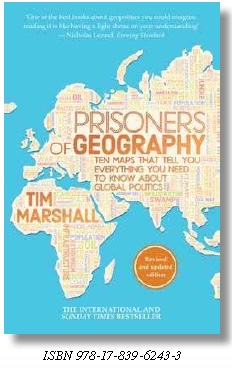“Prisoners of Geography: Ten Maps That Tell You Everything You Need to Know About Global Politics”
“After having read this book, one understands better the crises on this globe, demanding articles in the news become regarded as less fragmentary and a better overview is possible. The change from the single World Power USA to a multipolar world is already accomplished. Why this is so is explained in this decidedly readable and fascinating book.”


George Friedman from Stratfor Institute, speaking at the Chicago Council on Foreign Relations in early 20151, emphasised that the US will continue to wage war and that for almost exactly one hundred years US foreign policy has put on top of its agenda the doctrine that Germany and Russia must not come together. If so, this corresponds to the centuries-old, traditional British war and foreign policy for Europe, known as the “balance of power”, and also to the current Nato shift with international Rapid Forces to the eastern Russian border.
NATO’s transformation from a defense alliance into an instrument of attacks under the leadership of the USA, wars in the Middle East, now confusing alliance commitments in the Syrian conflict, armed secession in Eastern Ukraine and, as it seems, a German Defense Minister determined to do everything, are fatal reminders of the situation before the First World War. Then it only needed the Serbian sparks to blow Europe up. The fuses are laid. According to George Friedman, Germany has not yet decided to take over the leading role in Europe imposed on it by its allies. We remember: Scharping’s lie provided the pretext for the war in Kosovo, illegal under international law. The enormous suffering caused by the Depleted Uranium in the ammunition used by the Allies cannot be openly discussed up to this day.
It is becoming more difficult to overlook the signs of a new war and Europe’s citizens are increasingly concerned that a new engagement is in preparation. If you can’t close your eyes, if you want to understand the recent history of Europe, if you recognise the parallels to the First and Second World War in the movements of present days, we recommend Tim Marshall’s book “Prisoners of Geography: Ten Maps That Tell You Everything You Need to Know About Global Politics”.
The emphasis in this book is on Geo and means, in short: “Geopolitics looks at the ways in which international affairs can be understood through geographical factors”. From ten selected regions of the world the British author Tim Marshall always develops out of history the view into the present. And that consistently under geographic-topographical conditions.
The very first chapter makes it clear why Stalin had little intention of extending the former Soviet Union to the Atlantic after the Second World War, as generations of students and military strategists were told in their teachings.
Attacks on Russia and the securing of supply from the west were always carried out through the Northern European lowlands. Other ways are blocked through the mountains.
Napoleon chose this route, as did the German armies in the two world wars. Poland and Ukraine are once again deployment zones, becoming eminently important to the Western military, but it is currently posing a huge threat to Russia. We also learn why the control and closure of the “GIUK gap”2 of the Russian Navy once again blocks the way to the oceans.If then one can read in the daily news that all financial transactions from Europe to the US and back are handled via submarine transatlantic cables that run parallel to the “GIUK gap” and that the Russians with their submarines are possible to cut these cable connections, the reader recognises that under certain circumstances a war event is being prepared here.
The Chinese Silk Road Project, hardly recognised by the US, can be seen as the answer to the urging question of the world community. Eurasia grows together through this infrastructure program (One Belt One Road – OBOR). Train transportation from Peking to Duisburg several times a week is already underway. Russia supports this project. China wants a cooperation, not only on the Eurasian continent, but in all areas and in all functions. Through Gwadar, China makes accessible the Indian Ocean and connects Pakistan and Iran to the Eurasian Project. Important other chapters enlighten the present geopolitics of the USA, Western Europe, the Near-East, India and Pakistan, Korea and Japan as well as Latin America.
With the chapter about the Arctic, Marshall closes this exciting work. At this point, the so-called “climate change” is working for Russia. Nowhere else are the US and Russia as close to each other as at this point. The melting ice opens possibilities of new passages between the Atlantic and the Pacific. Here as well, is Russia in its own off-shore waters and goes relatively unnoticed and undisturbed with its nose ahead. After having read this book, one understands better the crises on this globe, demanding articles in the news become regarded as less fragmentary and a better overview is possible. The change from the single World Power USA to a multipolar world is already accomplished. Why this is so is explained in this decidedly readable and fascinating book. •
1 <link https: www.youtube.com>www.youtube.com/watch Uploaded on 01.04.2018
2 GIUK = The line between Greenland, Island and the United Kingdom, entrance way from the Arctic Sea to the Atlantic Ocean. At wartime closed by the USA and NATO respectively. Ref. <link http: www.nzz.ch>www.nzz.ch; International from 13 February 2018, p. 7